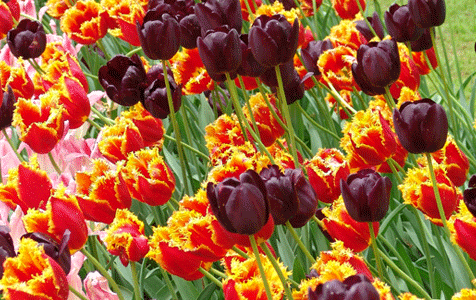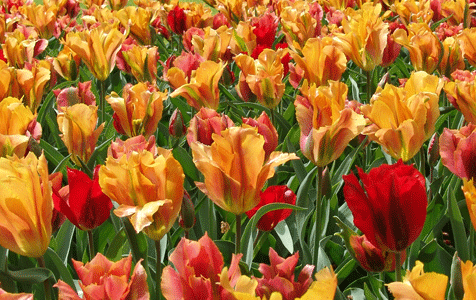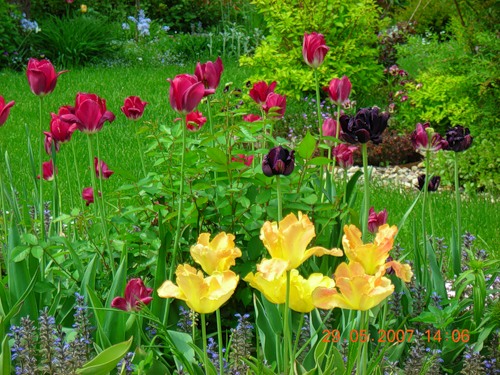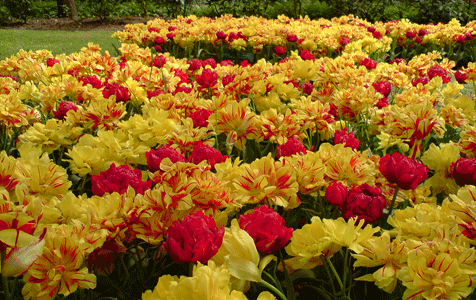Tulips are the most common culture in domestic gardening, because they have high lifestability, the possibility of distillation and the incomparable beauty of decorative inflorescences.
Content
If you are ready to grow tulips to decorate your own flower beds, then you need to carefully consider the selection of landing material. For beginner flower water, the specialized nursery of such colors will be the best option. The bulbs purchased here will correspond to the desired variety, as well as adapted to local climate conditions.
Features of tulips
The appearance of such plants as tulips depends on their variety. At the same time, the cost of bulbs of the most interesting and spectacular colors will usually be somewhat larger. In addition, many of them can be quite demanding to conditions and less lifestable, compared with common types.
Tulips have quite different shapes (liliepodobnuyu, goblet) and structure of the flower, and may also vary in height (to be up to 13 cm in length and 15 cm in diameter) and the color (to have a speckled, mixed, two color, perovidny, striped and monochrome drawing , simple and terry texture).
Tulip Season begins in May and lasts until the month of June, at the same time during the growing season have a rather short. After flowering bulbs go in relative quiet, and the leaves wither. During this period, the parent bulb time to form a new flower.
Species and varieties of tulips
All varieties of these flowers are divided into several groups, which correspond to a certain time of flowering and flower form. Simple early plants bloom in early May about 15-30 days and are suitable for forcing. The best representatives of this group of tulips are considered IbisMon Tresor and cooler Cardinal.
Early terry types bloom at the same time the previous and also suitable for forcing. The best representatives are: Murillo and Electra.
Species of tulips:
1. Darwin's hybrids (Parade, Oxford, artist, London).
2. Triumph (Karratha Algiba aviator).
3. liliales (Marietta, White Triumphant, Arcadia, Aladdin).
4. Briderovskie (Dillenburg).
5. parrot tulips (Ed Champion, Texas Gold, Black Parrot, Fantasy).
6. Mendelian (White Sayle, Ger Grace).
7. Darwinian (Holden Harvist, Korneforos, Tsvanenburg, Queen of the Night, Noble, Demeter).
8. Late terry tulips (Symphony, Mount Tecoma, Nice).
Propagation and cultivation of tulips
Propagated tulip in several ways:
- seeds;
- daughter bulbs, which arise in the axils of scaly parent bulb.
seed propagation
Seeds must be sown tulips around September and are very rare. It is advisable to do it in advance is not fertilized the soil, which must be fat and fluffy. They were then coated with a few centimeters good ground, mixed with sand.
Seeds do not require special care and germinate in the spring. In autumn, should fill at the site a little more fertile land. The following year, this action is repeated again.
On the third year, approximately in August, when the leaf of the plant pleases and buys, you can remove the bulbs and dry them a little. At the end of September, they are planted with a period of 10 cm on an open and dry section with a depth of about 10 cm. So they will need to transplant 2 more times, but at a distance of 15 cm. Only for the 6th year of the bulbs will begin to bloom.
Greeting of bulbs
Upon completion of flowering and after the leaves dried down (somewhere in July), it should be separated by a daughter bulb and dried up for several days outdoors, sticking from the rain and the scorching sun. Next, they are purified from horses, land and sorted.
Storage conditions of tulip bulbs:
- the first 3 weeks at + 20 ° C;
- then at + 15 ° C, gradually reducing the temperature to + 9 ... + 12 ° C.
Air humidity is recommended to be maintained within 80%. Such conditions must be observed until the lukovitz landing in the ground. If the temperature is higher, then the bulbs can be lined with flowering.
The annual digging of bulbs is a prerequisite for the cultivation of tulips. Only in this case will you increase the coefficient of breeding, combating diseases, pests and the growth of bulbs.
Tulips: landing and care
Success in the cultivation of these plants mainly depends on the correctness of the selected place and the soil preparation.
Recommendations for the placement of colors:
- place the tulips are best in wind protected and illuminated;
- it is necessary to choose a smooth area with a rich humid and light sulace soil;
- the best colors will grow in neutral or slightly alkaline earth;
- place the planting material recommended in a row, about 15 cm from each other, the depth must correspond to 10 cm;
- between the rows, observe the gap of about 30-40 cm;
- after the first frosts, the population populated must be covered with a 4 -30 cm by humus, foliage or straw;
- before planting, be sure to consider the source material (the peel must be quite clean, and the bulb is solid);
- the level of groundwater should not be more than 60 cm.
In the preparation of the clay area, the tulips was recommended to make river sand (2 buckets per 1 sq. M) and, if necessary, lime (50 per 1 sq. M). The bulbs should be planted in the autumn period so that they are pretty rooted before the onset of cold weather.
Care for tulips
With high-quality preparation of soil, tulips care is quite insignificant. It consists in constant watering, weeding and systematic soil looser.
Recommendations:
- flowers should be watered before the start of christmas of the above-ground part and within 14 days after the end of flowering;
- it is necessary to regularly pinch off the shrinking petals;
- periodically examine the plant and remove those that grow with defects;
- in the spring it is necessary to make mineral fertilizers to a depth of 10-12 cm;
- next time fertilize tulips needed during flowering period;
- in the process of flowering and vegetation, the plants should be abundantly and often water;
- during irrigation, see that the water does not get on the leaves.
Videos Tulips:



































